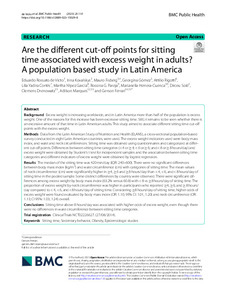Por favor, use este identificador para citar o enlazar este ítem:
https://repositorio.uca.edu.ar/handle/123456789/16627| Título: | Are the different cut-off points for sitting time associated with excess weight in adults? A population based study in Latin America | Autor: | de Victo, Eduardo Kovalskys, Irina Fisberg, Mauro Gómez, Georgina Rigotti, Attilio Cortés, Lilia Yadira Yépez García, Martha Cecilia Pareja, Rossina G. Herrera Cuenca, Marianella Solé, Dirceu Drenowatz, Clemens Marques, Adilson Ferrari, Gerson |
Palabras clave: | EPIDEMIOLOGIA; OBESIDAD; SEDENTARISMO | Fecha de publicación: | 2023 | Editorial: | BMC | Cita: | e Victo, E.R., et al. Are the different cut-off points for sitting time associated with excess weight in adults? A population based study in Latin America [en línea]. BMC Public Health. 2023, 23 doi:10.1186/s12889-023-15029-8 Disponible en: https://repositorio.uca.edu.ar/handle/123456789/16627 | Resumen: | Abstract: Excess weight is increasing worldwide, and in Latin America more than half of the population is excess weight. One of the reasons for this increase has been excessive sitting time. Still, it remains to be seen whether there is an excessive amount of that time in Latin American adults. This study aimed to associate different sitting time cut-off points with the excess weight. Methods: Data from the Latin American Study of Nutrition and Health (ELANS), a cross-sectional population-based survey conducted in eight Latin American countries, were used. The excess weight indicators used were body mass index, and waist and neck circumferences. Sitting time was obtained using questionnaires and categorized at different cut-off points. Differences between sitting time categories (< 4 or ≥ 4; < 6 or ≥ 6; and < 8 or ≥ 8 hours/day) and excess weight were obtained by Student's t test for independent samples and the association between sitting time categories and different indicators of excess weight were obtained by logistic regression. Results: The median of the sitting time was 420 min/day (IQR: 240-600). There were no significant differences between body mass index (kg/m2) and waist circumference (cm) with categories of sitting time. The mean values of neck circumference (cm) were significantly higher in ≥4, ≥6 and ≥ 8 hours/day than < 4, < 6, and < 8 hours/day of sitting time in the pooled sample. Some distinct differences by country were observed. There were significant differences among excess weight by body mass index (63.2% versus 60.8) with < 8 vs ≥8 hours/day of sitting time. The proportion of excess weight by neck circumference was higher in participants who reported ≥4, ≥6, and ≥ 8 hours/day compared to < 4, < 6, and < 8 hours/day of sitting time. Considering ≥8 hours/day of sitting time, higher odds of excess weight were found evaluated by body mass index (OR: 1.10; 95% CI: 1.01, 1.20) and neck circumference (OR: 1.13; CI 95%: 1.03, 1.24) overall. Conclusions: Sitting time above 8 hours/day was associated with higher odds of excess weight, even though there were no differences in waist circumference between sitting time categories. | URI: | https://repositorio.uca.edu.ar/handle/123456789/16627 | Disciplina: | MEDICINA | DOI: | 10.1186/s12889-023-15029-8 | Derechos: | Atribución 4.0 Internacional | Fuente: | BMC Public Health. 2023, 23 |
| Aparece en las colecciones: | Artículos |
Ficheros en este ítem:
| Fichero | Descripción | Tamaño | Formato | |
|---|---|---|---|---|
| different-cut-off.pdf | 832,84 kB | Adobe PDF |  Visualizar/Abrir |
Visualizaciones de página(s)
54
comprobado en 27-abr-2024
Descarga(s)
19
comprobado en 27-abr-2024
Google ScholarTM
Ver en Google Scholar
Altmetric
Altmetric
Este ítem está sujeto a una Licencia Creative Commons

